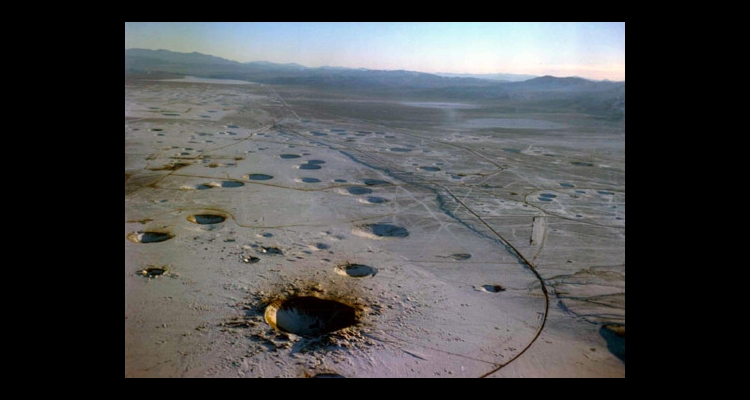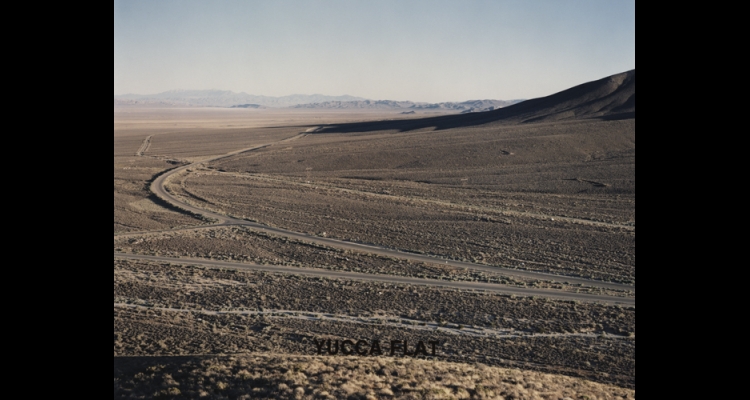Yucca Flat
Yucca Flat is a closed basin in the Nevada Test Site where 827 documented atmospheric and underground nuclear tests took place between 1951 and 1992—a total that represents almost eighty percent of all United States nuclear tests. The two-hundred square mile region lies to the east of the Nevada Test Site, about ten miles north of Frenchman Flat, and contains test areas 1 through 4, and 6 through 10.
The flat, open terrain, similar to that at Frenchman Flat, provided excellent visibility for photographing and filming atmospheric tests. The basin consists of sedimentary soil deposited from the erosion of the surrounding mountains. The depth and composition of the soil provided an ideal medium for the 747 underground nuclear tests conducted here, since it was relatively easy to drill the shafts for the tests.
South of the basin is Yucca Lake, a dry lakebed containing Yucca Airstrip. The airstrip’s location was convenient for flying in supplies and personnel to the test area. To the west of the airstrip is the control point complex where all nuclear tests at the Nevada Test Site were triggered and monitored; today, the control point supports ongoing operations at the site. Also close to the airstrip is News Nob, a rocky outcrop where reporters and VIPs watched the atmospheric tests from above the lakebed.
Yucca Flat contains hundreds of subsidence craters caused by underground nuclear testing. The heat of the nuclear explosion vaporized the soil and bedrock around it, creating a cavity onto which the surface soil collapses. Clearly seen on aerial and satellite photographs, the craters or subsidences give Yucca Flat a look similar to the surface of the moon.
Underground explosions in this test region never exceeded 500 kilotons, though some tests at Pahute Mesa exceeded one megaton. The government announced larger tests in advance as the shockwave caused by the explosions often caused earthquake-like activity in Las Vegas. In July 1974, the United States and Russia signed the Threshold Test Ban Treaty, limiting the size of underground tests to 150 kilotons. Even this limit did not prevent seismic activity in Las Vegas.
A number of notable nuclear tests took place at Yucca Flat. The 74-kiloton Hood test on July 5, 1957, part of Operation Plumbbob, was the largest atmospheric test ever conducted within the continental United States, and almost five times larger in yield than the bomb dropped on Hiroshima. Over 2000 service members took part in the test, designed to train them in conducting operations on the nuclear battlefield.
The Plumbbob test called John, on July 19, 1957, was the first test firing of the nuclear-tipped Genie air-to-air rocket designed to destroy incoming enemy bombers with a nuclear explosion. The two-kiloton warhead exploded approximately three miles above five volunteers and a photographer who stood at “ground zero” to show the apparent safety of battlefield nuclear weapons to personnel on the ground. The test also demonstrated the ability of a fighter aircraft to deliver a nuclear-tipped rocket and avoid being destroyed in the process.
Another significant event occurred at Yucca Flat during Operation Plowshare, the series of tests designed for peaceful uses of nuclear weapons. The Sedan test, on July 6, 1962, used a 104-kiloton device to test the possibility of using a nuclear explosion to build a harbor or a canal. The explosion displaced twelve million tons of earth, leaving a crater 1280 feet wide and 320 feet deep which is today on the National Register of Historic Places.
The final test at Yucca Flat, and the Nevada Test Site, was Divider on September 23, 1992, just prior to the October 1992 moratorium temporarily ending all nuclear testing.
In April 1997, the United States Department of Energy produced a report on a project called the Nevada Environmental Restoration Project. The focus of the report was the feasibility to remove or reduce the amount of radioactive material in the ground, and to monitor for possible contamination of the groundwater below the test sites. The project is ongoing as of 2007. Because of the great expense and virtual impossibility of cleaning up the test site, it has been categorized as a "national sacrifice zone."
Article Locations
Related Articles
None at this time.


